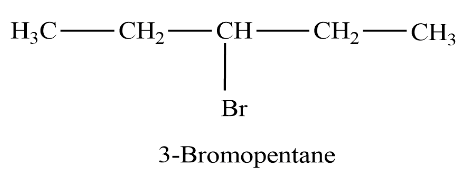
How many positional isomers are there in ${{\text{C}}_5}{{\text{H}}_{11}}Br$ ?
Answer
488.1k+ views
Hint: To answer this question we should learn about isomers first. Isomerism is a process in which compounds have different chemical structures but the same chemical formula. A Chemical compound that has the same chemical formula but a different chemical structure is known as an isomer.
Complete answer:
Isomers are of various types, positional isomers, chain isomers, functional isomers, and Stereoisomers, based on the orientation of the compound in three-dimensional space. Ther are divided into two categories, Geometric isomers, and Optical isomers.
In this question we are required to find the positional isomers of ${{\text{C}}_5}{{\text{H}}_{11}}Br$ or $1 - Bromopentane$
Let’s see what positional isomers are.
Positional Isomers: These are constitutional isomers that have the same carbon skeleton and same functional groups but they differ in the position of the functional group attached to the carbon chain. It involves the attachment of functional groups of different carbon atoms in the carbon chain.
Let see the structure of $1 - Bromopentane$

In this structure, we can see that the functional group Bromine is attached to the first carbon in the carbon chain.
now let’s see an isomer

In the above structure, we can see that the Functional group is attached to the second carbon in the carbon chain. So, the position of the functional group has changed and the chemical formula is still the same.
Let’s see another isomer

In this structure, we can see that the Functional group is attached to the third carbon in the carbon chain. So, the position of the functional group has changed and the chemical formula remains the same.
So, the given compound has three positional isomers.
Note:
The compound given has only three positional isomers because IUPAC naming is done according to some rules, one of those rules is that numbering of carbon starts from that carbon to which the functional group is attached so if we see the last structure if we change the position of Bromine again it will give the same isomers like the first two structures.
Complete answer:
Isomers are of various types, positional isomers, chain isomers, functional isomers, and Stereoisomers, based on the orientation of the compound in three-dimensional space. Ther are divided into two categories, Geometric isomers, and Optical isomers.
In this question we are required to find the positional isomers of ${{\text{C}}_5}{{\text{H}}_{11}}Br$ or $1 - Bromopentane$
Let’s see what positional isomers are.
Positional Isomers: These are constitutional isomers that have the same carbon skeleton and same functional groups but they differ in the position of the functional group attached to the carbon chain. It involves the attachment of functional groups of different carbon atoms in the carbon chain.
Let see the structure of $1 - Bromopentane$

In this structure, we can see that the functional group Bromine is attached to the first carbon in the carbon chain.
now let’s see an isomer

In the above structure, we can see that the Functional group is attached to the second carbon in the carbon chain. So, the position of the functional group has changed and the chemical formula is still the same.
Let’s see another isomer

In this structure, we can see that the Functional group is attached to the third carbon in the carbon chain. So, the position of the functional group has changed and the chemical formula remains the same.
So, the given compound has three positional isomers.
Note:
The compound given has only three positional isomers because IUPAC naming is done according to some rules, one of those rules is that numbering of carbon starts from that carbon to which the functional group is attached so if we see the last structure if we change the position of Bromine again it will give the same isomers like the first two structures.
Recently Updated Pages
A man running at a speed 5 ms is viewed in the side class 12 physics CBSE

The number of solutions in x in 02pi for which sqrt class 12 maths CBSE

State and explain Hardy Weinbergs Principle class 12 biology CBSE

Write any two methods of preparation of phenol Give class 12 chemistry CBSE

Which of the following statements is wrong a Amnion class 12 biology CBSE

Differentiate between action potential and resting class 12 biology CBSE

Trending doubts
What are the major means of transport Explain each class 12 social science CBSE

Which are the Top 10 Largest Countries of the World?

Draw a labelled sketch of the human eye class 12 physics CBSE

Explain sex determination in humans with line diag class 12 biology CBSE

Explain sex determination in humans with the help of class 12 biology CBSE

Differentiate between homogeneous and heterogeneous class 12 chemistry CBSE




